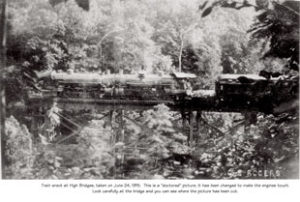2by James Rada, Jr.
Note: This is the second of three articles about the wreck of the Blue Mountain Express between Thurmont and Sabillasville in 1915.
 On June 25, 1915, the Blue Mountain Express, bound for Hagerstown, crashed head-on with a mail train traveling east from Hagerstown, crumpling the two engines and sending a baggage car off the bridge, where the crash occurred, and into the ravine below.
On June 25, 1915, the Blue Mountain Express, bound for Hagerstown, crashed head-on with a mail train traveling east from Hagerstown, crumpling the two engines and sending a baggage car off the bridge, where the crash occurred, and into the ravine below.
Thomas B. South of Hagerstown was in the passenger car next to the baggage car that crashed into the ravine. He felt a “grating sensation before the crash came.” The impact threw him forward against the seat in front of him.
“Mr. South said he could feel the car in which he was riding turn almost completely around and that it then tilted, as if it was going into the ravine,” reported the Herald Mail. “Women screamed and children cried when the awful impact came, and great difficulty was experienced in getting them out of the cars.”
Harry Smith of Hagerstown was seated in a passenger car of the Blue Mountain Express and “he felt the car topple and pieces of glass flew in every direction and many persons were badly cut,” according to the Hagerstown Herald Mail.
The two trains hit head-on. The baggage car on the Blue Mountain Express fell into the ravine, carrying with it two passengers: Mrs. W. C. Chipchase and her son, Walter.
“Mrs. Chipchase was going to be admitted to a sanitarium, was reclining in a baggage car, son and nurse with her…nurse left to stroll through the train, which probably saved her,” the Adams County News reported.
Mrs. Chipchase died in the fall, but Walter was found unconscious and groaning when rescuers reached him.
The Frederick News reported that Walter was taken to a cottage at Blue Ridge Summit, where his sister, Ethel, had been waiting for her brother and mother to arrive. He died around midnight.
The engines of the two trains had locked together on impact, “appearing as almost one engine to the horrified rescuers who quickly gathered on the scene. Had the engines ricocheted off of one another, there undoubtedly would have been more causalities,” according to a historical study of Catoctin National Park.
Eyler said, “Coals were falling from one of the boilers and for a time threatened to set fire to the wooden structure of the bridge. The whistle on one of the engines had stuck in an open position and kept blowing until all of the steam was gone.”
Within minutes of the crash, about one hundred people had gathered to help the survivors and find the dead amid the debris.
As the passengers and crew were located and pulled from the wreckage, two bodies were seen that could not be reached easily. Fireman Hayes’ body could be seen hanging from the train’s cab, but no one could reach it because the cab was hanging out over the ravine.
“It was impossible to move the body for fear that the slightest motion would hurl it to the bottom of the ravine nearly 100 feet below,” the Frederick News reported.
Dr. Morris Birely of Thurmont was the first doctor on the scene. He went to work treating the wounded as best he could. He worked into the night, using gas lanterns for light.
The Western Maryland Railroad sent two special trains to help in transporting the dead and wounded from the area. One train came from the east and the other the west.
All of the wreckage, except the connected locomotives, had been cleared from the bridge by morning.
“People were still wondering the next day how the two engines had stayed on the rails. But it was easy to see how the wreck had occurred. The bridge is ‘blind’ from both directions. From the east, a train passes out of a deep, curving cut right onto the bridge. From the west, an engineer had a little more visibility but was also on a curve and was traveling down-hill, making a quick stop impossible,” Eyler wrote.
In the end, six died in the crash of the Blue Mountain Express. They were: Coleman Cook, engineer; Luther Hull, fireman; J. R. Hayes, fireman; Mrs. W. C. Chipchase, Baltimore; Walter Chipchase, Baltimore. Twelve others suffered serious injuries. An investigation revealed that a mix-up in the all-important right-of-way orders issued from Hagerstown had caused the crash.
Bloom, “Pale and worn, the unmistakable signs of the worry he has experienced since hearing the result of his mistake,” according to the Adams County News, accepted responsibility for the accident.
Oddly, there were three Western Maryland Railroad officials on the Blue Mountain Express on their way to a meeting about the prevention of wrecks.

